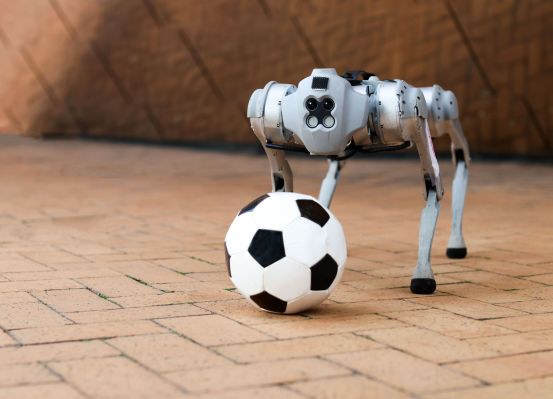Here’s a fun challenge: teaching a quadrupedal robot to successfully dribble a soccer ball. It is, in essence, a core component of RoboCup, the big international competition founded all the way back in 1996. Soccer is a great way to put a robot’s locomotion, agility and decision making to the test.
Two key differences with MIT’s Dribblebot: First, the RoboCup robots are generally bipeds. Second, and more importantly, this robot is designed to perform the complex task on uneven and changing terrain, adding yet another level of difficulty to the task.
“Past approaches simplify the dribbling problem, making a modeling assumption of flat, hard ground,” project co-lead Yandong Ji said in a post tied to the news. “The motion is also designed to be more static; the robot isn’t trying to run and manipulate the ball simultaneously. That’s where more difficult dynamics enter the control problem. We tackled this by extending recent advances that have enabled better outdoor locomotion into this compound task which combines aspects of locomotion and dexterous manipulation together.”
Potential terrains include grass (naturally), sand, gravel, mud and snow. The answer to all of the above is one that should be familiar to anyone with passing familiarity with the robotics space of late: simulation, simulation, simulation. In training, the physical robot is regarded as a “digital twin,” getting put through its paces as computers run 4,000 simultaneous simulations of different environments.
This sort of training clearly has broader applications beyond the admittedly narrow world of robot soccer. The debate around the efficacy of legged robots rages on, but one thing is certain: There are limitations to how far you can currently go on wheels.
“If you look around today, most robots are wheeled. But imagine that there’s a disaster scenario, flooding, or an earthquake, and we want robots to aid humans in the search and rescue process. We need the machines to go over terrains that aren’t flat, and wheeled robots can’t traverse those landscapes,” says MIT professor, Pulkit Agrawal. The whole point of studying legged robots is to go to terrains outside the reach of current robotic systems.”
Of course, Dribblebot has its own limitations, as well. Stairs and inclines still present a challenge for the little robot.
